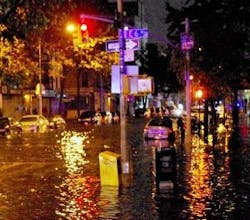Flooding from SuperStorm Sandy, a key reason why NY is pursuing REV. Credit: David Shankbone
New York is tackling the devilish details that will determine if Reforming the Energy Vision (REV) lives up to its promise of creating a market platform for microgrids and local energy.
Pricing, of course, is everything in energy markets. To that end, public service commission staff are preparing a proposal about who will pay for what on the distributed system platform, the exchange where demand-side resources will be bought and sold.
The benefit/cost analysis will help the state determine utility rates under REV and any necessary oversight by regulators, according to a solicitation for a consultant issued by the New York State Energy Research and Development Authority (NYSERDA).
The consultant will help state policymakers figure how local energy providers will pay to use the distributed system platform.
The state wants a design that encourages retail electric competition for demand-side products. At the same time, it hopes to establish a fair revenue stream for utilities, which are expected to manage the platform.
A range of players are likely to use the distributed exchange: entrepreneurs, energy service companies, utilities, businesses and consumers. The state is trying to give special attention to those who haven’t traditionally participated in energy markets, such as homeowners, low- and middle- income citizens, renters, small businesses, municipalities, and community groups.
It’s not clear yet what pricing method the distribution platform will use: subscription fees, transaction fees or some combination of both. The state also needs to figure out how to set fees for dispatch and balancing services, for access to potential customers through an information platform service, and for data and engineering analysis.
Determining platform fees can get complex. NYSERDA says in the solictiation that ‘two-sided market interdependencies’ could arise that impact pricing. Several questions therefore need to be addressed, according to the authority.
- Are there products or services (including platform access, dispatch service, or balancing service) that should be priced differently on the generator side of the market than on the consumer side of the market?
- How does this apply to so-called ‘pro-sumers’ who both generate and consume electricity?
- Could load management on the demand side be used to address intermittency on the generator side? How should platform fees be priced to enable such solutions?
- Could the platform pay electric vehicle owners for the ability to control the charging and discharging of their vehicle batteries? The vehicles would provide renewable generators with balancing or load leveling services.
That state hopes to complete the pricing analysis by year’s end. The full solicitation is available here. Bids from consultants are due April 22, 2015.
Microgrid comments due May 1
Separately, the PSC is seeking input by May 1 about the role of microgrids in New York’s new electricity market.
The commission is looking at possible microgrid configurations and their relationship to utilities. It has asked stakeholders to comment on how the state can assure that microgrid customers get reliable service at fair rates.
The goal is to protect consumers and encourage microgrid installation and innovation.
After reviewing the comments, commission staff will make a proposal to state regulators on microgrid configurations and oversight.
The commission’s microgrid inquiry is available here.
Stay on top of news about NY REV. Subscribe to the free Microgrid Knowledge newsletter.







